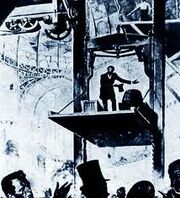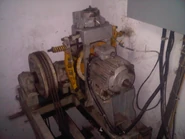
|
"This elevator needs to be fixed!" The content of this page or section needs to be rewritten. Please help the Elevatorpedia by expanding it. |

|
Elevator (or lift) is a vertical transport vehicle that efficiently moves people or goods between floors of a building. They are generally powered by electric motors that either drive traction cables and counterweight systems, or pump hydraulic fluid to raise a cylindrical piston.
History
Primitive elevators dates back to ancient Rome, where Archimedes designed one supported by hemp ropes and powered by animals. By the 1800s the technology had not greatly improved and the lifts that existed were notoriously dangerous. Due to the high risk, these lifts were reserved almost solely for moving objects, not people.
Medieval records contain numerous drawings of hoists lifting men and supplies to isolated locations. Among the most famous is the hoist at the monastery of St. Barlaam in Greece. The monastery stood on a pinnacle approximately 61 meters (200 ft) above the ground. Its hoist, which employed a basket or cargo net, was the only means up or down. At an abbey on the French seacoast, a hoist was installed in 1203 that used a large tread wheel. A donkey supplied the lifting power. The load was raised by a rope wound on a large drum. Manpower supplied the lifting force in many early devices. By the 18th century, machine power was being applied to the development of the elevator.
In 1743, a counterweighted personal elevator was commissioned by Louis XV in France for his personal chambers in Versailles. By 1833, a system using reciprocating rods raised and lowered miners in Germany’s Harz Mountains. A belt-driven elevator called the “teagle” was installed in an English factory in 1835. The first hydraulic industrial elevator powered by water pressure appeared in 1846. As machinery and engineering improved, other powered lifting devices quickly followed.
First elevator invention by Otis

Otis demonstrates his safety elevator at the 1953 World's Fair.
On 1953, an inventor named Elisha Otis had designed a safety system that would catch a falling lift should its main support fail. He proudly demonstrated this breakthrough at the 1853 World’s Fair in New York’s Crystal Palace. Otis stood on the elevated platform high above the crowd then directed a burly assistant to sever the support cable with an axe. The platform dropped a few inches but the safety system quickly stopped the descent.
A few years later when a state-of-the-art building was constructed to house the E.V. Haughwout chinaware emporium, the architects decided to include the very first Otis passenger elevator at a cost of $300. That same elevator is still in working condition.
The first successful passenger elevator was installed on this day at 488 Broadway in New York City on March 23, 1857.
In 1880, Werner von Siemens invented the first electric elevator.
Elevator drive systems
Traction
Main article: Traction elevators Elevator cars are pulled up by means of rolling steel ropes over a deeply grooved pulley, commonly called a sheave in the industry. The weight of the car is balanced by a counterweight. Sometimes two elevators are built so that their cars always move synchronously in opposite directions, and are each other's counterweight.
Geared traction
As the name implies, the electric motor in this design drives a wormand-gear-type reduction unit, which turns the hoisting sheave. While the lift rates are slower than in a typical gearless elevator, the gear reduction offers the advantage of requiring a less powerful motor to turn the sheave. These elevators typically operate at speeds from 38 to 152 meters (125-500 ft) per minute and carry loads of up to 13,600 kilograms (30,000 lb). An electrically controlled brake between the motor and the reduction unit stops the elevator, holding the car at the desired floor level.
Gearless traction
In a gearless traction machine, six to eight lengths of wire cable, known as hoisting ropes, are attached to the top of the elevator and wrapped around the drive sheave in special grooves. The other ends of the cables are attached to a counterweight that moves up and down in the hoistway on its own guiderails. The combined weight of the elevator car and the counterweight presses the cables into the grooves on the drive sheave, providing the necessary traction as the sheave turns.
To reduce the load on the motor, the counterweight is calculated to match the weight of the car and a half-load of passengers. As the car rises, the counterweight descends, balancing the load. This reduces energy consumption because the motor is required to lift no more than the weight of half a car load at any time. The grooved sheave in this traditional gearless system is quite large, from 0.6 to 1.2 meters (2–4 ft) in diameter. The electric motor that runs it must be powerful enough to turn this large drive sheave at 50–200 revolutions per minute in order to move the elevator at the proper rate.
Safety is provided by a governing device that engages the car’s brakes, should the elevator begin to fall. A powerful clamp clutches the steel governor cable, which activates two safety clamps located beneath the car. Moveable steel jaws wedge themselves against the guiderails until sufficient force is exerted to bring the car to a smooth stop.
M.R.L. traction
Main article: Machine Room Less Elevator
Hydraulic
Main article: Hydraulic elevators Hydraulic elevators are used extensively in buildings up to five or six stories high. These elevators—which can operate at speeds up to 46 meters (150 ft) per minute—do not use the large overhead hoisting machinery the way geared and gearless systems do. Instead, a typical hydraulic elevator is powered by a piston that travels inside a cylinder. An electric motor pumps oil into the cylinder to move the piston. The piston smoothly lifts the elevator cab. Electrical valves control the release of the oil for a gentle descent.
Holed hydraulic
With holed hydraulic systems, the elevator car is mounted on a piston that travels inside a cylinder. The cylinder extends into the ground to a depth equal to the height the elevator will rise. As hydraulic fluid is pumped into the cylinder through a valve, the car rises. As the fluid returns to the reservoir, the car descends.
Holeless hydraulic
Holeless hydraulic consists of pistons mounted inside the hoistway to raise and lower the car. This is especially a solution for buildings built in bedrock, a high water table or unstable soil conditions locations that can make digging the hole required for a conventional hydraulic elevator impractical.
Roped hydraulic
Roped hydraulic elevator extends the rise of the holeless elevator to 18 meters (60 ft), without the need for a belowground cylinder.
Elevator control
Automatic control
As passengers step on and off an elevator, the load constantly changes, making it difficult to keep the platform level with the floor. Otis solved this problem as far back as 1915 with a self-leveling device called Microdrive. First developed for lifts in naval vessels, Otis introduced it as a safety device in passenger elevators. It also saved time and improved the ride quality for passengers as the leveling operation was automatic.
Older elevators before 1980s uses mechanical selectors that uses analog controls and many moving parts to determine the car’s position, requiring constant and often costly maintenance.
Breakthroughs in computer technology continue to enhance the quality and reliability of modern elevators. Beginning in 1979 with Otis’ Elevonic®101 system, the power of microprocessors has been increasingly employed to control every aspect of elevator operation.
Judging when to slow the cab was easy enough for an operator when speeds were between 91–121 meters (300–400 ft) per minute. But when speeds increased to over 213 meters (700 ft) per minute, this became too difficult. The logical step was to automate the control system.
In 1924, Otis installed its first Signal Control System in the new Standard Oil Building in New York City. The system automatically controlled acceleration, speed between floors and deceleration as the car approached the landing. In 1937, the Peak Period Control was introduced to automatically schedule elevator service during high-demand periods. It helped reduce the waiting time on any given floor by coordinating the movement of the building’s elevators.
Electric door safeguards and more sophisticated dispatching systems followed, allowing elevators to become fully automatic.
Elevator algorithm
Main article: Elevator algorithm
Types of elevators
Main article: Types of elevators
Elevators have many types for passengers and freight.
Elevator special modes
- Anti-Crime Protection (ACP)
- Emergency power operation (EPR)
- Fire service mode (EFS)
- Independent service (ISC)
- Inspection service (INS)
- Medical emergency/Code Blue service (EHS)
- Sabbath service (SHO)
